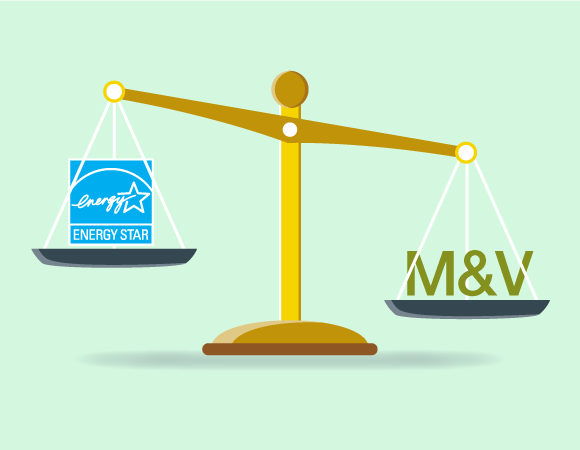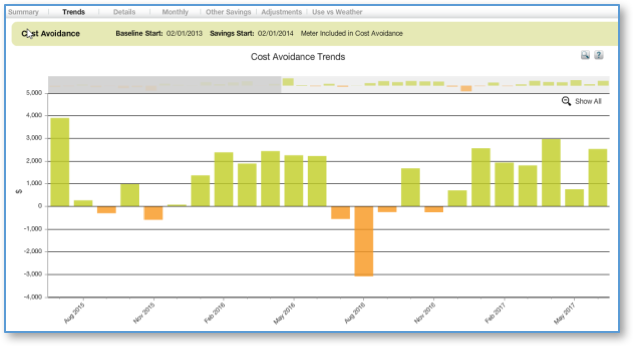 ENERGY STAR® is the nation’s most widely used and recognized energy reporting and benchmarking system, but it is seldom considered to be a method of measurement and verification (M&V) of savings. EnergyCAP, Inc.’s CEO, Steve Heinz, recently led a study
ENERGY STAR® is the nation’s most widely used and recognized energy reporting and benchmarking system, but it is seldom considered to be a method of measurement and verification (M&V) of savings. EnergyCAP, Inc.’s CEO, Steve Heinz, recently led a study
to determine if ENERGY STAR ratings can be used as a low-cost,
simple M&V method when the cost of a more intensive analysis is not justified. Steve presented the results of his study at the most recent World Energy Engineering Congress in Atlanta, GA.
The research correlated the increase in ENERGY STAR ratings with the M&V results for matching time periods to determine if an increase in ENERGY STAR rating can be shown to reliably mirror the results of a much more comprehensive–and expensive–IPMVP M&V analysis. If the data shows that an increase in ENERGY STAR rating of x% can confidently reflect a savings improvement of y%, then change in ENERGY STAR can be used as a no-cost quantitative predictor of savings, hence M&V. ISO 50015:2014 does not mandate any particular M&V method, but rather puts the burden on the M&V practitioner to document the method and the rationale for its selection in the M&V Plan. Accordingly, an M&V Plan can be ISO 50015 compliant by using a trusted alternative to IPMVP.
{{cta(‘549fec34-0824-46a9-ac8e-654f2fadf87c’,’justifycenter’)}}
Analyzed in the study were 306 public K–12 school buildings that underwent energy conservation initiatives while simultaneously receiving ENERGY STAR ratings and IPMVP Option C M&V reports. Buildings in which energy conservation measures were implemented on a performance basis were used, because performance contracts are highly dependent upon accurate M&V, providing assurance that the M&V calculations had professional attention and oversight. Additional study details:
- Buildings were located in multiple climate regions (temperate, desert, Mediterranean).
- The changes in ENERGY STAR rating and savings were taken over a 12- to 24-month period during the performance period.
- Buildings that had ENERGY STAR ratings of 100 or 0 were excluded, as the ratings indicated a data submission problem.
M&V calculations were performed in EnergyCAP®. EnergyCAP’s Cost Avoidance methodology and core calculations date back to 1982 and adhere to Option C, the “Whole Facility Method,” in the International Performance Measurement & Verification Protocol (IPMVP).

The study showed that the general trend was as expected in 68% of the buildings: the ENERGY STAR rating and use avoidance percentage increased or decreased together. However, in 30% of the buildings one increased when the other decreased or remained unchanged. The following conclusions were drawn from those mixed results:
- In very approximate terms, a one-point increase in ENERGY STAR rating correlates to a 0.8 % increase in building energy efficiency, as measured by use avoidance percentage.
- The correlation is not strong enough to allow a recommendation of ENERGY STAR as an alternative M&V method for an ISO 50015 M&V Plan, particularly for performance contracts which require high confidence in savings reports.
- ENERGY STAR is a convenient, free and easy-to-use method of assessing relative overall building energy efficiency, but it lacks the mechanisms for the fine-tuning of analysis that the M&V Practitioner typically needs for performance-based energy management projects.
If you would like to receive more details regarding Steve Heinz’s study, please contact us to request a copy of his WEEC presentation. For an introduction to Measurement & Verification, I encourage you to download our free eBook, titled “An Introduction to Measurement & Verification.” The eBook discusses the history of computer-assisted M&V, the four primary M&V methods, and the benefits of IPMVP Option C for whole-facility energy analysis.
{{cta(‘9b814de3-a25c-4ea5-9d99-e106c0664a67′,’justifycenter’)}}
 Best-in-class portfolio-level energy and utility bill data management and reporting.
Best-in-class portfolio-level energy and utility bill data management and reporting.
 Real-time energy and sustainability analytics for high-performance, net-zero buildings.
Real-time energy and sustainability analytics for high-performance, net-zero buildings.
 A holistic view of financial-grade scope 1, 2, and 3 carbon emissions data across your entire business.
A holistic view of financial-grade scope 1, 2, and 3 carbon emissions data across your entire business.
 Energy and sustainability benchmarking compliance software designed for utilities.
Energy and sustainability benchmarking compliance software designed for utilities.
 ENERGY STAR® is the nation’s most widely used and recognized energy reporting and benchmarking system, but it is seldom considered to be a method of measurement and verification (M&V) of savings. EnergyCAP, Inc.’s CEO, Steve Heinz, recently led a study
ENERGY STAR® is the nation’s most widely used and recognized energy reporting and benchmarking system, but it is seldom considered to be a method of measurement and verification (M&V) of savings. EnergyCAP, Inc.’s CEO, Steve Heinz, recently led a study


